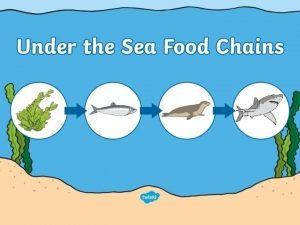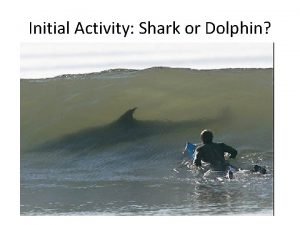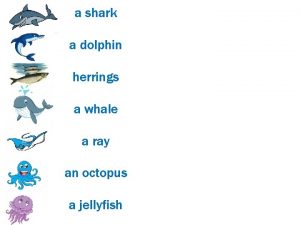Under The Sea Adventure The Dolphin the Shark











- Slides: 11

Under The Sea Adventure The Dolphin, the Shark, the Killer Whale, Jellyfish and the Sting ray.

Dolphin • Blowholes located in their heads open and close, • • • allowing the dolphins to breathe. (Being mammals, dolphins have to come to the water's surface to breathe, just like you. ) Males are larger than females and can be as long as 13 feet (4 meters) and weigh more than a thousand pounds (454 kilograms). Females give birth every two to three years, normally one calf after a pregnancy of one year. The calves are often born tail first so they don't drown. Bottlenose dolphins swim in groups called pods. A pod usually has a dozen or so animals.

• Bottlenose dolphins send messages to one another in • different ways. They squeak and whistle and use body language—leaping as high as 20 feet (6 meters) in the air, snapping their jaws, slapping their tails on the surface of the water, and even butting heads. dolphins are carnivores (meat eaters). http: //www. sciencekids. co. nz/sciencefacts/animals/dolphin. html http: //kids. nationalgeographic. com/kids/animals/creaturefeature/bottlenose-dolphin/

The Shark • Not all species of shark give birth to live pups. Some • • species lay the egg case on the ocean floor and the pup hatches later on its own. Great whites are the deadliest shark in the ocean. These powerful predators can race through the water at 30 km per hour. Unlike other species of shark, the great white is warmblooded. Although the great white does not keep a constant body temperature, it needs to eat a lot of meat in order to be able to regulate its temperature.

• A shark always has a row of smaller teeth developing behind its front teeth. Eventually the smaller teeth move forward, like a conveyor belt, and the front teeth fall out. Adult great white sharks can swim up to speeds of 43 miles (69 kilometers) an hour. Shark attacks on humans are rare. However, the species of shark that tend to be most dangerous to humans include great white sharks, tiger sharks, and bull sharks. Most shark attacks on humans have occurred in the waters of the United States. • • http: //kids. nationalgeographic. com/kids/animals/creaturefeature/great-white-shark/ http: //www. sciencekids. co. nz/sciencefacts/animals/shark. html

The Killer Whale • Orcas have good eyesight both underwater and above the surface. • Orcas usually swim at a speed of about 3 to 4 miles (5 • • • to 6. 4 kilometers) an hour. Each lobe of the whale's tail is called a fluke. Orcas are able to reach a speed of about 30 miles (48 kilometers) an hour. A thick layer of fat, or blubber, helps an orca stay warm even in icy waters. Orcas are toothed whales and a kind of dolphin. They are the largest of all dolphins.


Jellyfish • All jellyfish sting, but the stings of small specimens • • • and those with short tentacles often are not painful to humans. Even dead jellyfish can sting. Jellyfish eat plankton. Some can be very hard to see, nearly invisible to the human eye. Although the word is mentioned in their name, jellyfish are not fish. A group of jellyfish is called a ‘bloom’, ‘swarm’ or ‘smack’. Large blooms can feature over 100000 jellyfish.

• • • Jellyfish live in the sea and are found in all oceans. Some jellyfish live in fresh water. Jellyfish look a little like umbrellas. Jellyfish can be large and brightly colored. They can often be transparent (see-through) or translucent (semi-translucent). Jellyfish don’t have brains. http: //www. sciencekids. co. nz/sciencefacts/animals/jellyfish. html : //kids. nationalgeographic. com/kids/animals/creaturefeature/jellyfish/

Stingray • stingrays, with their wide, flat bodies, may not look • • • like fish, but they are. They are related to sharks, and, like their shark cousins, they do not have bones. Instead, their bodies are supported by cartilage—the same material that you feel inside the tip of your nose. A stingray in the wild can live to be 15 to 25 years old. Stingrays can grow to be up to 6. 5 feet (2 meters) long and weigh up to 790 pounds (358 kilograms). If something or someone steps on a stingray, it will likely defend itself by lashing its tail and striking its enemy with the sharp spine.

• The spine causes a very painful wound, which can be deadly. • The stingray's spine is an extension of its tail. • Their eyes are located on the top of the head, but they don't use eyes to find prey. http: //kids. nationalgeographic. com/kids/animals/creaturefeature/stingray/ http: //www. softschools. com/facts/animals/stingray_facts/41/
 Great white shark and hammerhead shark
Great white shark and hammerhead shark My favourite sea animal dolphin
My favourite sea animal dolphin Sea base florida keys
Sea base florida keys Food chain under the sea
Food chain under the sea A brief description
A brief description Food chain examples
Food chain examples Pi·ha·hiʹroth
Pi·ha·hiʹroth Sea stump
Sea stump What is asias largest desert
What is asias largest desert Anemones phylum
Anemones phylum What does the sea symbolize in the old man and the sea
What does the sea symbolize in the old man and the sea Led soldiers across hellespont into anatolia
Led soldiers across hellespont into anatolia




















